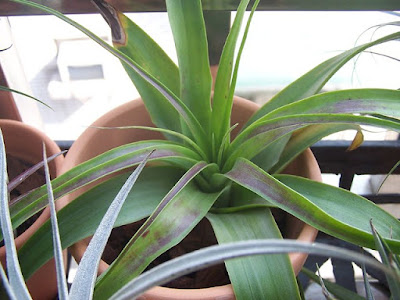Tillandsia polystachia is native to Central America, the West Indies (Greater Antilles, Lesser Antilles, Bahamas), Bolivia, Colombia, Brazil, Ecuador, Mexico and Venezuela. It grows epiphytic at altitudes ranging from sea-level up to 1800 meters.
Tillandsia polystachia, also called as Renealmia polystachia, Platystachys polystachia, Tillandsia angustifolia, is a species of the genus Tillandsia. This species was described by Carl Linnaeus in 1762.
IDENTIFY TILLANDSIA POLYSTACHIA AIR PLANT
Tillandsia polystachia is native to Central America, the West Indies (Greater Antilles, Lesser Antilles, Bahamas), Bolivia, Colombia, Brazil, Ecuador, Mexico and Venezuela. It grows epiphytic at altitudes ranging from sea-level up to 1800 meters.
It is a large sized epiphytic acaule (up to 80 cm in height at flowering) with many leaves that form a rosette, soft, light green / greyish. The sheaths are oval but indistinct, the limbs are triangular, flat and can curl strongly if the plant lacks water.
This air plant bloom from the dense and narrow inflorescence borne by a peduncle of 30 cm, with several flat and linear ears often tight, giving a cylindrical appearance to the inflorescence. The bracts of the flowering stem resemble leaves and are nested, curved, green or red. The primary bracts are much shorter. The floral bracts are oval, slightly imbricate, leathery, with some small veins at the apex that is often red (sometimes margins too). The flowers are almost sessile, 2 cm, tubular, mauve or purple. The sepals are hairless and leathery. The stamens and the pistil are exserts.
TILLANDSIA POLYSTACHIA AIR PLANT CARE AND CULTURE
Cultural information should only be used as a guide, and should be to be adapted to suit you. Your physical location; where you grow your plants, how much time you have to devote to their care, and many other factors, will need to be taken into account. Only then can you decide on the cultural methods that best suit you and your plants.
Light:
Tillandsia polystachia requires average brightness, without direct sun. This species is best to grow indoor or in shade of others plant.
Temperature:
The required temperature ranging from 10 to 32°C. Get it early enough in the fall if you grow it outside, so that it does not face night temperatures below 6 ° C, especially if it is wet. The plants can faced temperatures close to 0 ° C (sheltered and dry) for a few hours without damage.
Humidity:
This air plant need the moderate to high level of humidity. In the case of high level humidity, watering should be reduced. Good aeration is required, the plant must dry quickly (in less than an hour).
Substrate, growing media and repotting:
Tillandsia polystachia refer to be mounted on a solid substrate that does not retain water. This species can also be grow in pot. Place the plant very close to a window inside. If you grow it outdoors in the summer, put it in the shade. You can glue the plant directly to the surface with a strong adhesive, or you can wire the plant to the base. Don't cover the base of the plant with moss or it may rot. It can be grown on almost any imaginable decorative mount, including shells, rocks, slate, driftwood, etc.
Watering:
Two or three times a week in summer, one to two times a week in winter according to the luminosity and the ambient humidity. Obviously when it rains and if you grow it outside, it counts as a watering.
Fertilizer:
This air plant can be fertilized with the moderate doses. 1 to 2 times a month in the summer and 1 time a month in the winter.















COMMENTS